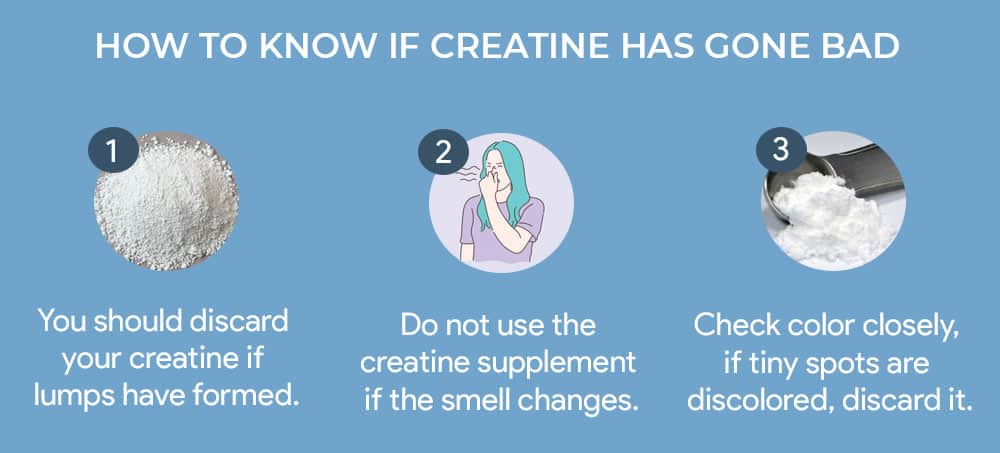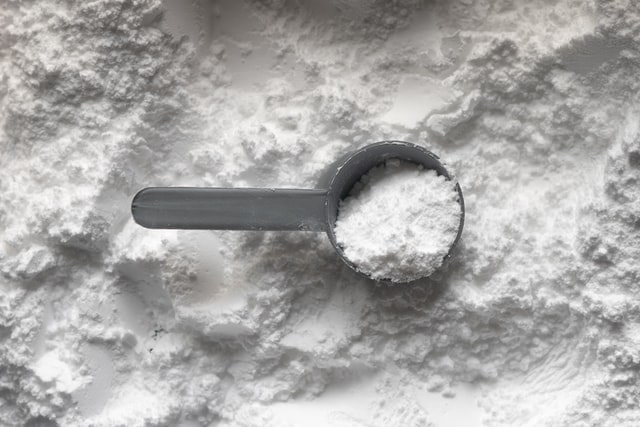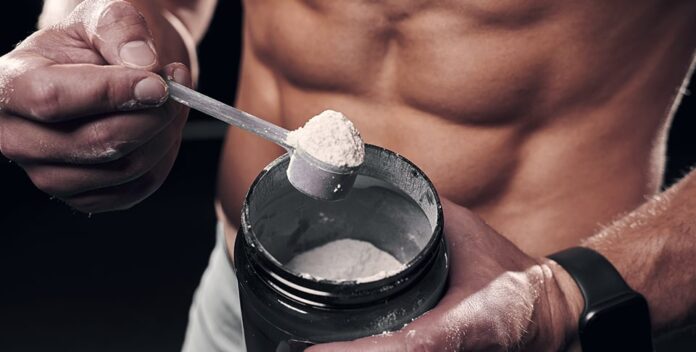When it comes to fitness supplements, creatine stands out as a powerhouse, offering enhanced performance, increased muscle growth, and improved endurance. But as with any product, questions arise about does creatine expire and shelf life. In this comprehensive guide, we will explore the topic of creatine expiration, answering queries such as “Can creatine go bad?”, “Is clumpy creatine bad?” and shedding light on its shelf life. So, let’s dive in and uncover the truth about creatine’s longevity.
Does Creatine Expire? Understanding the Shelf Life and Creatine Expiry Date

Creatine monohydrate, a popular form of creatine, boasts exceptional stability. It can maintain its potency even beyond the labeled expiration date. This remarkable stability arises from its chemical structure, which allows it to withstand environmental factors like heat, moisture, and light. Thus, creatine supplements can often retain their effectiveness for extended periods.
Purchasing creatine supplements from reputable brands that prioritize quality control is advisable to ensure maximum freshness and potency. These trusted manufacturers ensure that their products undergo rigorous testing, ensuring purity, potency, and accurate labeling.
If you want to know can you bring creatine on a plane? Click here.
Clumpy Creatine
One common concern is clumpy creatine, where solid lumps form within the powder. However, clumps do not necessarily indicate that the creatine has expired or turned bad. Clumping occurs due to exposure to moisture, which causes the particles to stick together. Fear not, as clumpy creatine can still be safely consumed. Simply break up the clumps before use to restore it to its original form.
It’s worth noting that proper storage is essential to minimize clumping. Ensure the creatine container is tightly sealed and stored in a cool, dry place away from moisture. By following these storage practices, you can maintain the quality and effectiveness of your creatine supplement.
Understanding Expiration Dates and Potency
Expiration dates on creatine supplements provide a general guideline, but they are not absolute deadlines for usability. Creatine, especially creatine monohydrate, can remain potent beyond the indicated expiration date. The expiration date serves as an estimation of when the product may gradually lose effectiveness.
Factors such as proper storage, exposure to air, moisture, and extreme temperatures can influence creatine’s potency over time. Therefore, storing your creatine in a cool, dry place, away from direct sunlight and excess humidity, is crucial to preserve its potency.
Signs of Expired Creatine

While creatine generally remains safe for consumption even after the expiration date, there are certain signs that indicate it may be time to replace your supply. If you notice any significant changes in color, such as discoloration or a strong, unpleasant odor emanating from the container, it’s best to exercise caution and discontinue use. Additionally, suppose the taste of the creatine becomes noticeably different or you experience any discomfort after consumption. In that case, it’s advisable to err on the side of caution and seek a fresh supply.
Remember, these signs are rare occurrences with properly stored creatine. By adhering to appropriate storage practices and being mindful of any unusual changes, you can ensure the safety and quality of your creatine supplementation.
Maximizing Safety and Potency
To ensure the longevity and effectiveness of your creatine, it’s important to follow a few key practices. Firstly, check the expiration date when purchasing creatine and opt for reputable brands known for their quality. Proper storage plays a vital role, so store the supplement in a cool, dry place, sealed tightly to minimize exposure to air and moisture. This way, you can maximize its shelf life and maintain its potency.
Furthermore, if you have concerns about consuming expired creatine or notice any signs of spoilage, it is advisable to purchase a fresh tub for peace of mind. Creatine is relatively affordable, and ensuring its freshness and efficacy is worth the investment.
In addition to proper storage, it’s essential to adhere to recommended dosage guidelines. Taking creatine in the appropriate amounts and following the instructions provided by the manufacturer can help optimize its benefits while minimizing the risk of any potential side effects.
It’s important to note that while creatine supplements can offer significant benefits to exercise performance and muscle growth, they should be approached as part of a comprehensive fitness and nutrition plan. Seeking guidance from a healthcare professional or a registered dietitian is always advisable, especially if you have any underlying health conditions or are taking medications.
Safely Incorporating Creatine into Your Fitness Routine
Now that you better understand creatine expiration and shelf life, let’s explore how to safely incorporate this supplement into your fitness routine.
Consult with a Healthcare Professional
Before taking a new dietary supplement, remember to consult with a registered dietitian or a healthcare professional. They can evaluate your individual needs, consider any underlying health conditions or medications you may be taking, and provide personalized recommendations for incorporating creatine into your regimen.
Start with a Loading Phase
Many athletes and fitness enthusiasts choose to begin their creatine supplementation with a loading phase. This involves taking a higher dose of creatine for a short period, typically 20 grams per day divided into four 5-gram servings, for the first 5-7 days. The loading phase helps saturate your muscles with creatine, allowing you to experience its benefits more quickly.
Transition to Maintenance Phase
After the loading phase, you can transition to a maintenance phase where you take a lower daily dose of creatine to maintain the increased creatine levels in your muscles. The recommended daily maintenance dosage generally falls within the range of 3-5 grams.
Timing and Frequency
When it comes to timing your creatine supplementation, there is no one-size-fits-all approach. Some individuals prefer taking creatine before their workouts, while others opt for post-workout consumption. Explore various timings to determine the optimal schedule that suits your needs. As for frequency, taking creatine daily is generally recommended to maintain consistent levels in your muscles.
Hydration is Key
Creatine has the ability to enhance muscle fullness and promote cell volumization by facilitating the retention of water within your muscles. To ensure optimal hydration and support this process, it is essential to maintain adequate fluid intake throughout the day. Aim to drink sufficient water, aiming for around 8-10 glasses daily. If you are regularly engaging in intense physical activity or residing in a warm climate, you may need to increase your water intake even further to meet your body’s hydration demands. By prioritizing hydration, you can optimize the benefits of creatine and support your overall performance and well-being.
Monitor Your Progress
As you incorporate creatine into your fitness routine, pay attention to how your body responds. Keep track of your strength gains, endurance improvements, and body composition changes. Everyone’s response to creatine can vary, so observing how it specifically benefits you is important.
Combine Creatine with a Balanced Diet
While creatine can provide excellent performance and muscle-building benefits, it should not be seen as a substitute for a well-rounded diet. To optimize your results, combine creatine supplementation with a balanced diet rich in lean proteins, complex carbohydrates, and various fruits and vegetables. This will provide your body with the necessary nutrients to support overall health and maximize your fitness goals.
The Future of Creatine and Ongoing Research

As scientific knowledge and research continue to advance, the realm of creatine supplementation is an area of ongoing investigation. Researchers continually explore new facets of creatine’s effects, potential applications, and optimal usage protocols. Here are some exciting areas of research that may shape the future of creatine supplementation:
Creatine and Cognitive Function
While creatine is primarily associated with its benefits in athletic performance, recent studies have also examined its potential cognitive-enhancing properties. Preliminary research suggests that creatine supplementation may have positive effects on cognitive performance, particularly in tasks requiring short-term memory, mental processing speed, and fatigue resistance. Further studies are needed to fully understand the cognitive benefits of creatine and its potential applications.
Combination Therapies
Researchers are exploring the potential synergistic effects of combining creatine with other substances or interventions. For example, combining creatine with resistance training or specific dietary strategies may enhance muscle growth and strength gains. Additionally, investigations into the use of creatine as an adjunct therapy for various medical conditions, such as neurodegenerative diseases or muscle-wasting disorders, are ongoing.
Alternative Forms of Creatine
While creatine monohydrate remains the most widely studied and commonly used form of creatine, researchers are exploring alternative formulations to enhance its solubility, bioavailability, and absorption. These alternative forms, such as buffered creatine or creatine salts, aim to address any potential gastrointestinal side effects and optimize the delivery of creatine to target tissues.
Individual Response Variability
As with any dietary supplement, individual response to creatine can vary. Some individuals may experience greater performance, muscle growth, or cognitive function benefits, while others may respond less noticeably. Ongoing research aims to identify the factors contributing to this individual variability, such as genetics, metabolism, or microbiome composition, to understand better and personalize creatine supplementation protocols.
Long-Term Safety and Health Implications
Although creatine has been extensively studied and generally considered safe for short-term use, there is ongoing research into its long-term safety and potential health implications. Studies continue to monitor the effects of prolonged creatine supplementation on various health parameters, including kidney and liver function, cardiovascular health, and hormonal profiles. This research aims to comprehensively understand creatine’s safety profile, particularly with extended use.
By staying informed about emerging research and advancements in creatine supplementation, you can make educated decisions about your own usage and potentially benefit from new discoveries in the field.
Frequently Asked Questions about Creatine Expiration
To further address any lingering concerns or questions you may have about creatine expiration, here are some frequently asked questions:
Can creatine monohydrate expire?
Like other forms of creatine, Creatine monohydrate has a long shelf life and can maintain its potency well beyond the expiration date. It can still be safely consumed as long as it is appropriately stored and shows no signs of spoilage.
Does creatine powder go bad?
Creatine powder, including creatine monohydrate, can potentially clump due to moisture exposure, but clumpy creatine does not necessarily indicate spoilage or ineffectiveness. Breaking up the clumps before use ensures that the creatine powder mixes well and can be consumed without any issues.
How long does creatine last?
The shelf life of creatine supplements can vary depending on factors such as storage conditions and the specific product. However, properly stored creatine, especially creatine monohydrate, can maintain its potency for several years beyond the expiration date.
Can you take expired creatine?
Expired creatine is generally safe to consume, but its potency may have diminished over time. If you choose to take expired creatine, it is recommended to monitor for any unusual changes in color, odor, or taste and discontinue use if any significant changes are observed.
How to tell if creatine is expired?
While creatine generally remains stable even after the expiration date, inspecting the product for any signs of spoilage is essential. Look for significant changes in color, such as discoloration or an off-putting odor. If the taste of the creatine has significantly altered or if you experience any discomfort after consumption, it’s best to err on the side of caution and replace the product.
What happens when creatine expires?
When creatine expires, its potency may gradually diminish. This means the supplement’s effectiveness in providing its intended benefits, such as improved performance and muscle growth, may be reduced. However, consuming expired creatine is unlikely to cause harm as long as there are no signs of spoilage.
Is it safe to take expired creatine pills?
Expired creatine pills, similar to other forms of creatine, can be consumed safely as long as there are no signs of spoilage. It’s important to evaluate the pills for any appearance, odor, or taste changes. If the pills show any significant alterations, it’s recommended to discontinue use and replace them with fresh ones.
Remember, it’s always advisable to check with the manufacturer or a healthcare professional if you have any specific concerns about a particular creatine product.
Conclusion
In this comprehensive guide, we have explored the topic of does creatine expire and addressed common concerns surrounding the shelf life and effectiveness of creatine supplements. We have learned that creatine, particularly creatine monohydrate, is a highly stable compound that can maintain its potency well beyond the labeled expiration date.
We discussed the proper storage practices to prolong the shelf life of creatine, including keeping it in a cool, dry place away from moisture and extreme temperatures. We also emphasized the importance of inspecting the product for any signs of spoilage, such as changes in color, odor, or taste.
Throughout the guide, we debunked the myth that clumpy creatine is necessarily expired, clarifying that clumping can occur due to exposure to moisture but does not render the creatine ineffective or harmful to consume. Breaking up the clumps before use ensures the creatine mixes well and retains its benefits.
We also highlighted the importance of adhering to recommended dosage guidelines and seeking guidance from healthcare professionals or registered dietitians before incorporating creatine into your fitness routine, especially if you have underlying health conditions or take medications.
Furthermore, we provided tips on safely incorporating creatine into your fitness regimen, including starting with a loading phase, transitioning to a maintenance phase, timing your supplementation, staying hydrated, and combining creatine with a balanced diet.
Lastly, we addressed frequently asked questions about creatine expiration, offering insights into the safety and efficacy of expired creatine and how to identify potential spoilage.
By following the information and guidelines provided in this guide, you can confidently navigate the world of creatine supplementation, maximize its benefits, and support your fitness goals effectively.
Remember, consistency, proper storage, and monitoring for any changes in the product are key to ensuring the quality and effectiveness of your creatine supplements. Stay dedicated, listen to your body, and enjoy the performance-enhancing and muscle-building advantages that creatine can provide.


